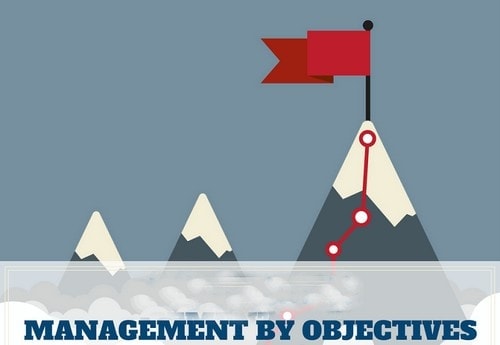‘Management by objectives’ (MBO) is a strategic management technique in which the main aim is to improve performance of the organization by defining objectives. It is also known as ‘management by results’ (MBR).
Table of Contents
Understanding the concept of MBO
Management by objective is a term which was first coined by Peter F. Drucker in his book “Practice by Management” in the year 1954. It is a management philosophy based on a personnel management model.
This model represents the performance of an organization in which all of the employees and the managers work together so that they can set the record and achieve the objectives that are oriented for a particular organization in a specific period.
According to this technique, Drucker stated that when there is a particular goal that is being set for an organization and its follow up actions are planned, then this encourages the employees to participate and commit to the work with full dedication.
This also helps in aligning the entire objective in one particular direction for the entity. Now the entire core concept of this model is based on ‘planning.’
MBO requires the goals to be set first of all, and then the people working in that organization can work together to achieve that desired goal.
This process of management by objectives is quite a supervised and managed activity. In this type of model, it is shown that both the superiors and the subordinates, who are belonging to a particular organization, will work together so that they can achieve the desired objectives and targets of the entity.
It also specifies the responsibilities to each of the employees individually so that they know what they have to do, and unnecessary confusion can be avoided.
All of these measures are taken so that the unit can be run effectively due to the honest contribution of each of the employees.
The goals that are set through this model are monitored throughout till the time it gets completed perfectly. This is one so that its progress can be checked regularly and improvement can be made wherever and whenever necessary.
And the rewards and then given pending upon how effectively the goals have been achieved.
In general, the management by objectives is the establishment of a management system which issued to compare the actual performance and the achievements that have been n previously defined by the organization.
It helps a lot in increasing the motivation of the employees they are given with a target to chase and a well-prepared action plan that they can follow.
It makes them more committed to their work and also enhances a better flow of communication between the employees and the management. Now the book from which this concept has been taken, in that the writer proposes several principles based on the MBO.
In this, the objectives are meant to be challenging, but also it should be achieved at the same time. For this to happen, the employees must receive feedback regularly, and their main focus is on the rewards rather than the punishment.
More emphasis is put on personal growth and development. In this way, Drucker proposed the MBO as a tool that would do a lot of benefits to the organization.
What are the different conditions that must be met for the management by objectives (MBO)?
Now before we have a look at the conditions that are required for the MOB, let us first take a look at the assumptions that are made for the management by objectives.
So the MBO basically relies on the fact that it is human nature that people often tend to perform in a better way when they are aware of the things that can expect in the form of the outcome and also when they are genuinely able to associate with their personal goals to that of the objective of the organization that they are working for.
Now here are a few conditions that are needed to be met for the management by the objectives-
- The main objectives of the organization are determined by the employees of that particular entity.
- These objectives are generally formulated at both the two levels, which are the qualitative and the qualitative level.
- The more challenging and motivating the objectives are, the better results it will produce.
- Daily feedbacks are given on the state of affairs t various levels of coaching and also its growth and development instead of the reports of the static management.
- The main principle is based on growth and development and not on the punishments.
What are the steps involved in MBO?
The MBO is a process that is followed by the employers and the managers in order t attempts to manage the subordinates by working towards a set of targeted objectives that will eventually benefit both the employees and the company as well.
It is all about striving to achieve those set of goals by working towards them constantly.
Now mainly there five steps involved in management by objectives (MBO) which are as follows-
- Reviewing the organizational goals
- Setting the objectives for the workers
- Constantly keeping a check on the progress by monitoring it regularly
- Evaluation of the work done
- Giving out rewards on the successful completion of the work.
Now lets us discuss all of these steps in detail
- Now in the first step, the determination of the objective of the organization is done, and in some cases, it is revised thoroughly for the entire company. This broader overview is determined by the vision and the mission of the firm.
- In the second step, the translation of the objectives of the organization is done so to the employees so that they can clearly understand the concept and the views of the organization.
- In the third step, the simulation of the simulation is done, which is to set a spate objective for every individual so that by the end, one common final objective can be achieved.
- In the fourth step, the progress of the employees is monitored individually, and a track record is maintained of their progress report.
- And in the fifth and the last step, the entire process and its results are evaluated, and then the managers and the employees of the workforce are rewarded accordingly.
Advantages and Disadvantages of MBO
Advantages of MBO
Now there are countless distinct advantages of the management by objectives. Out of which some of them are discussed below-
- It enables the employees to the task and the duties that they have to perform in the organization in a better way.
- It proves to be of great help when it comes to preparing a design for the Key Result Area (KRA), for every single employee, which will solely depend upon the interest, experience their specialization and the confusion that they may have regarding the duties or the task that they are going to perform.
- Due to the MBO, every single employee who is working for the organization can contribute to the objectives set by that entity by completing the tasks or the duties that they are assigned to, by their superiors.
- It promotes open communication and better coordination. This is because, in the MBO, revise and feedbacks are given to the employees regularly. It also happens because of the healthy interaction that takes place between the people that are working together in an organization.
- It also focuses more on the clarity of the goals so that unnecessary confusions can be avoided.
- It brings motivation among the employees, which in turn enables them to work harder. This also helps in increasing the job satisfaction as well as their commitment towards the job.
- MOB also provides one more befit to the mangers in which they can fully ensure that each of the subordinates is directly linked to the directive principle of the management.
- MBO brings out a common goal for the entire organization. It increases the unity among the people that are working together for an entity and hence produces better results.
- Also, the MBO avoids any kind of confusion or the overlapping of the duties and the task of the individual employees.
Disadvantages
Now the management by objectives (MBO) comes with a lot of benefits. But there is still a disadvantage that is associated with the MBO. And that is how the MBO emphasizes the goals set.
The MBO generally unduly emphasizes the attainment of the objectives and does work on a systematic plan for the same.
Here is a video by Marketing91 on Management by Objectives.
Conclusion
Thus the management by objective (MBO) is quite an important model that needs to be taken into consideration by all of the organizations so that all of the employees and the managers working in it can work with their fullest potential; keeping the objective of the organization in their minds and hence achieve the desired goals of the organization.
Liked this post? Check out the complete series on Management


